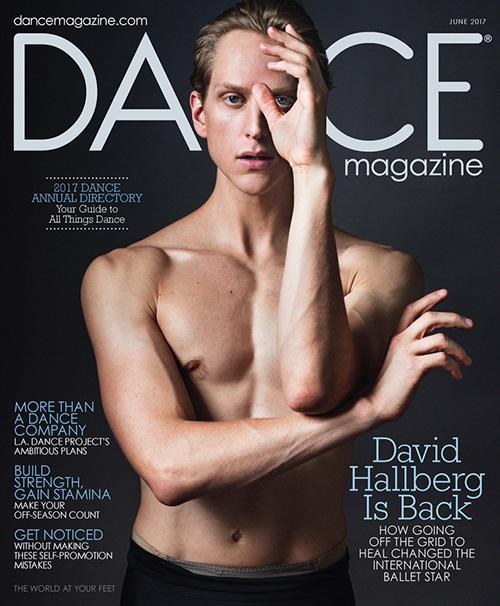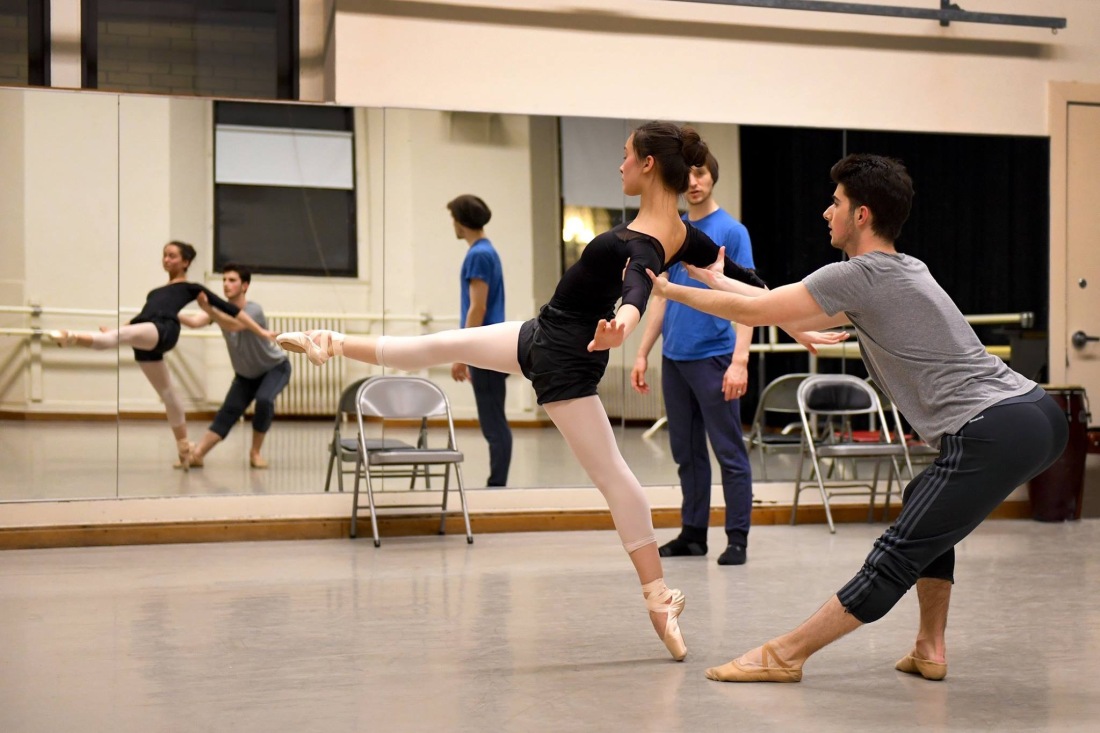 The first day that I worked with American Ballet Theatre was filled with an enormous sense of accomplishment and a great deal of anxiety. It was during my final year of training at the School of American Ballet when I was one of 4 boys offered a trial contract with the company to go on tour to the Kennedy Center as a member of the corps de ballet in MacMillan’s Romeo and Juliet (before ABT’s JKO school existed). I was David Hallberg’s 2nd cast when he would step out of the corps as the 2nd cast for Benvolio and I was tasked with learning intricate fencing and intertwining corps sequences from the moment I walked into the studio. My excitement of dancing with my dream company was equally balanced by my stress level, as I had never been shown so much choreographic material at once or been expected to retain it with such immediacy. This style of learning was a grand departure from what I was used to in school when it came to learning new material and preparing to perform it. Now that I have moved forward into the realm of choreography and coaching for a range of student and professional dancers, I use experiences I’ve had as a tool to help prepare dancers in the most appropriate, economical fashion possible.
The first day that I worked with American Ballet Theatre was filled with an enormous sense of accomplishment and a great deal of anxiety. It was during my final year of training at the School of American Ballet when I was one of 4 boys offered a trial contract with the company to go on tour to the Kennedy Center as a member of the corps de ballet in MacMillan’s Romeo and Juliet (before ABT’s JKO school existed). I was David Hallberg’s 2nd cast when he would step out of the corps as the 2nd cast for Benvolio and I was tasked with learning intricate fencing and intertwining corps sequences from the moment I walked into the studio. My excitement of dancing with my dream company was equally balanced by my stress level, as I had never been shown so much choreographic material at once or been expected to retain it with such immediacy. This style of learning was a grand departure from what I was used to in school when it came to learning new material and preparing to perform it. Now that I have moved forward into the realm of choreography and coaching for a range of student and professional dancers, I use experiences I’ve had as a tool to help prepare dancers in the most appropriate, economical fashion possible.
There are a couple of ways in which students are treated differently when it comes to preparing for performances. Those moving in the direction of a professional career will often learn choreographic content that is progressively closer to what professionals perform. When I learned my first classical pas de deux at the age of 15, I learned it off a VHS tape (yep, throwing it back) of fully realized dancers in performance. While we were young and had not completely developed as artists, we put in our best effort and performed the pas de deux as we saw it on the video. While a teacher or coach can offer a simplified version of choreography, student dancers will (for the most part) perform the same steps as professionals. The only difference here is that technical tricks like pirouettes may not be performed with as many rotations or certain sequences may be simplified for safety until enough strength and coordination is gained.
One of the main differences when it comes to coaching a student is the amount of time allotted to learn the work, clarify material, and build stamina. When I performed the Don Quixote pas de deux for my graduation performance at the Kirov Academy of Ballet (you can see footage here), we began rehearsing for our May show at the beginning of February. With 2-4 hours of rehearsal each week on the pas de deux alone plus additional time for rehearsal of the variations, we had many hours of practice to ensure that we knew the steps, understood the characters, and had the physical prowess to get through this challenging, pyrotechnic 8 minute piece. Students are often given a greater cushion of time to allow them to safely find their way through the material of a professional while still working as a student.

The final aspect of coaching kids that differs from working with pros comes in the form of how the coach approaches corrections. For me, I find that there is a huge emotional aspect when it comes to giving feedback, as it involves giving that feedback and seeing how the student responds both physically and psychologically. I have been coaching students to compete at the Youth America Grand Prix (YAGP) international ballet competition for nearly 4 years. My approach has changed over this period as I have gathered more experience working with different kids from a range of schools. When I first started working with new students, I would coach them in the same way that I was throughout my final years of training and as a professional. I gave direct feedback that got straight to the point without any coddling or wasted time. What I found was that some students felt demoralized by certain corrections, as they weren’t used to this style of coaching, weren’t taught how to receive corrections in that way, or didn’t understand that a correction wasn’t an attack on them as a person. Dance can be confusing in that way because while we are correcting the body’s form and the way one portrays a character with their face, it doesn’t mean that there is something wrong with a dancer as person. It is just our pathway to express our art form and necessary to convey characters through dance. Now, when coaching my students, I make sure that we take time throughout lessons to discuss corrections, why I am giving them, and how they should be addressed.
This past week, 4 students I worked with competed in the final round at YAGP. One 13 year old in particular that I worked very closely with this season has made great progress throughout our rehearsal process. When we began, I offered a warmer approach to guiding her through corrections. As she developed during our time together, I began to alter my approach to working with her and started to give more direct feedback. By the end of the final round of the competition while discussing how she felt about her performances, it became clear that she had matured to a point where she understood critical feedback and had began self-critiquing her performances. In that moment, I recognized that she was ready to begin working in a more professional format. I sat her down and explained that my approach with her in class and rehearsals will be changing. I noted that I will greatly increase my expectations of her in class and rehearsals and that she should be prepared for a much tougher approach from me. I am a big advocate of teaching emotional well-being to my students and I feel it is important to carefully guide kids and teens into a state of understanding when it comes to extremely critical feedback. With this student in particular, she is there.

I tend to go back and forth between periods of working with students and professionals as a coach. Generally, when I work as a coach with professionals, it often comes in the form of me choreographing on them and then providing feedback to ensure that they perform my work at the highest caliber. After reading the above information, you can probably see where I am going when it comes to explaining the coaching process with pros versus students. Coaching professionals is much different than working with kids. There isn’t as much emotional coddling in a professional work environment. With less time available in most professional rehearsal processes, corrections are given in a matter-of-fact way and it is expected that they will immediately address issues. We also expect dancers to be critiquing themselves and working to fix issues before we have to call them out.
Beyond all of this, most rehearsal periods are much shorter for the pros. As I was discussing at the beginning of this post, going from learning choreography as a student to rehearsing with American Ballet Theatre, I experienced a major learning curve. There wasn’t really a progressive period from student to professional where I was shown how to learn choreography at the speedier rate in a company. This tends to be a sink-or-swim period for new dancers coming into their own. I was one of the lucky ones that figured out how to learn material at a much faster pace. Without much guidance, many talented dancers fall behind their peers with this new expectation. To help a bit with the learning curve, many apprentices and young corps dancers spend multiple hours of their rehearsal days standing in the back of the room understudying roles. They are essentially being taught how to retain material faster. For this reason, it is so important that professional division students in schools and early career dancers that are asked to understudy take this role very seriously.
There is no guidebook when it comes to coaching dancers to perform at their best. But it is important that those of us who are coaching students don’t blindly walk into a studio and treat dancers exactly as we were taught. It is important to look at the individual dancer and assess what their needs are. Sometimes, this comes in the form of finding appropriate material for the physical form of a students. While at other times, it includes determining how to build a dancer’s emotional stamina. If this process is appropriately followed for the individual, we will create professional dancers who can function properly in the challenging work environment that often accompanies company work. And in the end, students who become company dancers will have all of the tools they need to become efficient at their jobs and help their organizations turn out the best product possible.